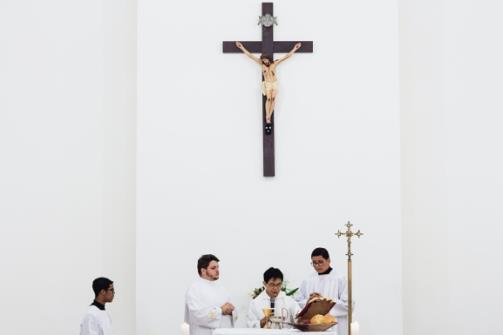
 Controversial and possibly long-lasting effects from the coronavirus pandemic are being felt in Christian churches and the way they celebrate the sacrament of communion. This can be seen in new online observances and rituals that have emerged, but also challenges have been posed to smaller but ancient ways of celebrating this central sacrament. It is an issue that cuts across the usual conservative-liberal divide, with, for instance, both low-church conservative and liberal Lutherans holding virtual communion services while high church Lutherans opposing such innovations. The Journal of Anglican Studies (18) notes that the debate over “virtual Eucharists” has broken out in various Anglican churches, though even the liberal Episcopal Church has officially condemned the practice, holding that it overrides the actions of the priest in consecrating the bread and wine. Editor Andrew McGowan writes that the debate about virtual Eucharists is part of a larger disruption in Anglican ritual and liturgy afforded by the virus that coincides with the disruption caused by the Internet itself. “Anglicans are now sharing in prayer with others (not just other Anglicans) all over the world now, seeing things they had not before, hearing familiar words in unfamiliar cadences and new words spoken in unfamiliar holy places…Worship may indeed be changed; it may increasingly be streamed even when available in the flesh, and perhaps even hybridized by including streamed elements, but it will not cease to be primarily a physical and communal activity if it remains characteristically Christian.”
Controversial and possibly long-lasting effects from the coronavirus pandemic are being felt in Christian churches and the way they celebrate the sacrament of communion. This can be seen in new online observances and rituals that have emerged, but also challenges have been posed to smaller but ancient ways of celebrating this central sacrament. It is an issue that cuts across the usual conservative-liberal divide, with, for instance, both low-church conservative and liberal Lutherans holding virtual communion services while high church Lutherans opposing such innovations. The Journal of Anglican Studies (18) notes that the debate over “virtual Eucharists” has broken out in various Anglican churches, though even the liberal Episcopal Church has officially condemned the practice, holding that it overrides the actions of the priest in consecrating the bread and wine. Editor Andrew McGowan writes that the debate about virtual Eucharists is part of a larger disruption in Anglican ritual and liturgy afforded by the virus that coincides with the disruption caused by the Internet itself. “Anglicans are now sharing in prayer with others (not just other Anglicans) all over the world now, seeing things they had not before, hearing familiar words in unfamiliar cadences and new words spoken in unfamiliar holy places…Worship may indeed be changed; it may increasingly be streamed even when available in the flesh, and perhaps even hybridized by including streamed elements, but it will not cease to be primarily a physical and communal activity if it remains characteristically Christian.”
Meanwhile, in the Eastern Orthodox churches, the use of a common spoon for giving communion during the virus has made a number of the faithful apprehensive and has led some Orthodox jurisdictions, dioceses and parishes to allow certain changes in the manner of administering communion, while some are still deliberating on this matter, writes Alexei Krindatch in a new report. The study is part of series of surveys on the impact of the pandemic in American Orthodox Christian parishes. The study was initiated by the Orthodox Theological Society in America, conducted in late July, and based on the responses of 609 Orthodox priests representing all American Orthodox jurisdictions. At the time of the study, only a quarter of the parishes had been able to fully resume their liturgical life, without rules limiting the number of participants. Traditionally, communion is served with the same spoon and from a common chalice. Nearly half of US Orthodox parishes administer the Holy Communion in exactly the same way as they did prior to the pandemic, with variations across jurisdictions.
“Parishes of the Greek Orthodox Archdiocese (GOA, 61 percent of parishes) and of the Russian Orthodox Church Outside of Russian (ROCOR, 70 percent) adhere most strongly to serving Holy Communion in a traditional manner,” Krindatch reports. In contrast, only 25 percent of the Orthodox Church in America (OCA) parishes continue giving communion in this way. One-fifth of the parishes require communicants to tilt their heads back so that the priest can drop communion into their mouths without physical contact of communicant with the spoon. The study finds that 13 percent of the parishes use either one or several spoons in rotation which are then sanitized; 12 percent use multiple reusable spoons (one per communicant). There are also parishes offering different options. Internal diversity is the strongest within the OCA. In half of the parishes, the priests responded that some members refrain from receiving communion due to fear of getting sick. The highest percentage is found in parishes sticking to the traditional method. Opinions about changes in the way of giving communion are contrasted among clergy of all jurisdictions. Overall, 55 percent of clergy believe that “participation in the Holy Communion is critical, not the manner of its distribution.” Clergy in the OCA are on average most open to accept new methods for administering communion. Krindatch concludes that “the distinctive ‘internal culture’ of each jurisdiction is the most important predictor of the clergy’s personal opinions and feelings on this topic”—something that illustrates the difficulty of enforcing uniform policies across Orthodox jurisdictions and dioceses.
(Journal of Anglican Studies, https://www.cambridge.org/core/journals/journal-of-anglican-studies; the report “Holy Communion during the Pandemic in American Orthodox Christian Parishes” (53 pages) as well as an executive summary can be downloaded from the following page: https://orthodoxreality.org/coronavirus-and-american-orthodox-parishes/)